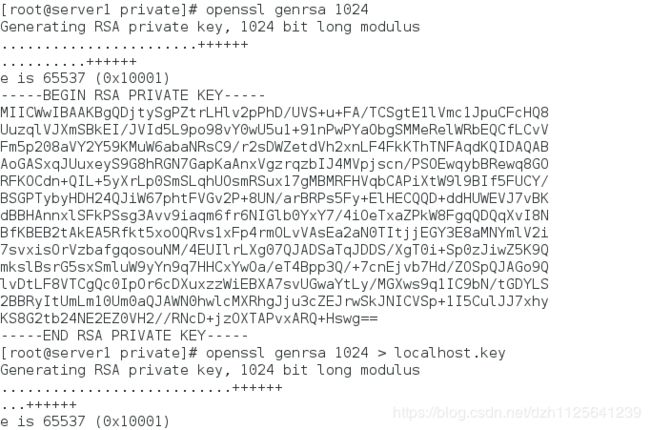SaltStack--API调用
API调用
利用api接口来实现SaltStack推送,管理集群是非常方便的手段
1.在server1上安装salt api
[root@server1 ~]# yum install -y salt-api-2018.3.3-1.el7.noarch.rpm
2.配置自签名证书
[root@server1 private]# pwd
/etc/pki/tls/private
[root@server1 private]# openssl genrsa 1024
[root@server1 private]# openssl genrsa 1024 > localhost.key
localhost.key
[root@server1 private]# ll
total 8
-rw-r--r-- 1 root root 887 Jun 19 10:32 localhost.key ##要有读的权限
-rw-r--r-- 1 root root 887 Jun 19 10:05 local.key
[root@server1 private]# cd ../certs
[root@server1 certs]# make testcert
3.编辑api.conf和auth.conf
[root@server1 certs]# vim /etc/salt/master #只支持以.conf结尾的文件
[root@server1 certs]# cd /etc/salt/master.d/
[root@server1 master.d]# vim api.conf
[root@server1 master.d]# cat api.conf
rest_cherrypy:
port: 8000
ssl_crt: /etc/pki/tls/certs/localhost.crt
ssl_key: /etc/pki/tls/private/localhost.key
[root@server1 master.d]# vim auth.conf
[root@server1 master.d]# cat auth.conf
external_auth:
pam:
saltapi:
- .*
- '@wheel'
- '@runner'
- '@jobs'
4.创建用户并设置密码
[root@server1 master.d]# useradd saltapi
[root@server1 master.d]# passwd saltapi ##密码为redhat
Changing password for user saltapi.
New password:
BAD PASSWORD: The password is shorter than 8 characters
Retype new password:
passwd: all authentication tokens updated successfully.
5.打开salt-api,重启salt-master,并查看是否监听8000端口
[root@server1 master.d]# systemctl start salt-api
[root@server1 master.d]# systemctl restart salt-master
[root@server1 master.d]# netstat -antlp | grep 8000
tcp 0 0 0.0.0.0:8000 0.0.0.0:* LISTEN 15435/salt-api
6.验证服务并获得token
[root@server1 master.d]# curl -sSk https://localhost:8000/login -d username=saltapi -d password=redhat -d eauth=pam
{"return": [{"perms": [".*", "@wheel", "@runner", "@jobs"], "start": 1560912154.411231, "token": "8c49fd8495c432cfa81f3
![]()
7.利用token号测试minion是否通
[root@server1 master.d]# curl -sSk https://localhost:8000 -H 'Accept: application/x-yaml' -H 'X-Auth-Token: b67576688061ab7e70de50c082933f60790fcc1c' -d client=local -d tgt='*' -d fun=test.ping
return:
- server2: true
server3: true
8.编写saltapi的python脚本
[root@server1 ~]# vim saltapi.py
# -*- coding: utf-8 -*-
import urllib2,urllib
import time
try:
import json
except ImportError:
import simplejson as json
class SaltAPI(object):
__token_id = ''
def __init__(self,url,username,password):
self.__url = url.rstrip('/')
self.__user = username
self.__password = password
def token_id(self):
''' user login and get token id '''
params = {'eauth': 'pam', 'username': self.__user, 'password': self.__password}
encode = urllib.urlencode(params)
obj = urllib.unquote(encode)
content = self.postRequest(obj,prefix='/login')
try:
self.__token_id = content['return'][0]['token']
except KeyError:
raise KeyError
def postRequest(self,obj,prefix='/'):
url = self.__url + prefix
headers = {'X-Auth-Token' : self.__token_id}
req = urllib2.Request(url, obj, headers)
opener = urllib2.urlopen(req)
content = json.loads(opener.read())
return content
def list_all_key(self):
params = {'client': 'wheel', 'fun': 'key.list_all'}
obj = urllib.urlencode(params)
self.token_id()
content = self.postRequest(obj)
minions = content['return'][0]['data']['return']['minions']
minions_pre = content['return'][0]['data']['return']['minions_pre']
return minions,minions_pre
def delete_key(self,node_name):
params = {'client': 'wheel', 'fun': 'key.delete', 'match': node_name}
obj = urllib.urlencode(params)
self.token_id()
content = self.postRequest(obj)
ret = content['return'][0]['data']['success']
return ret
def accept_key(self,node_name):
params = {'client': 'wheel', 'fun': 'key.accept', 'match': node_name}
obj = urllib.urlencode(params)
self.token_id()
content = self.postRequest(obj)
ret = content['return'][0]['data']['success']
return ret
def remote_noarg_execution(self,tgt,fun):
''' Execute commands without parameters '''
params = {'client': 'local', 'tgt': tgt, 'fun': fun}
obj = urllib.urlencode(params)
self.token_id()
content = self.postRequest(obj)
ret = content['return'][0][tgt]
return ret
def remote_execution(self,tgt,fun,arg):
''' Command execution with parameters '''
params = {'client': 'local', 'tgt': tgt, 'fun': fun, 'arg': arg}
obj = urllib.urlencode(params)
self.token_id()
content = self.postRequest(obj)
ret = content['return'][0][tgt]
return ret
def target_remote_execution(self,tgt,fun,arg):
''' Use targeting for remote execution '''
params = {'client': 'local', 'tgt': tgt, 'fun': fun, 'arg': arg, 'expr_form': 'nodegroup'}
obj = urllib.urlencode(params)
self.token_id()
content = self.postRequest(obj)
jid = content['return'][0]['jid']
return jid
def deploy(self,tgt,arg):
''' Module deployment '''
params = {'client': 'local', 'tgt': tgt, 'fun': 'state.sls', 'arg': arg}
obj = urllib.urlencode(params)
self.token_id()
content = self.postRequest(obj)
return content
def async_deploy(self,tgt,arg):
''' Asynchronously send a command to connected minions '''
params = {'client': 'local_async', 'tgt': tgt, 'fun': 'state.sls', 'arg': arg}
obj = urllib.urlencode(params)
self.token_id()
content = self.postRequest(obj)
jid = content['return'][0]['jid']
return jid
def target_deploy(self,tgt,arg):
''' Based on the node group forms deployment '''
params = {'client': 'local_async', 'tgt': tgt, 'fun': 'state.sls', 'arg': arg, 'expr_form': 'nodegroup'}
obj = urllib.urlencode(params)
self.token_id()
content = self.postRequest(obj)
jid = content['return'][0]['jid']
return jid
def main():
sapi = SaltAPI(url="https://172.25.68.1:8000",username="saltapi",password="westos")
#sapi.token_id()
print sapi.list_all_key()
#sapi.delete_key('test-01')
#sapi.accept_key('test-01')
sapi.deploy('server2','apache.install')
#print sapi.remote_noarg_execution('test-01','grains.items')
if __name__ == '__main__':
main()
9.使用python执行脚本
server2先关闭httpd,server1执行saltapi.py脚本后,server2的httpd服务开启
[root@server2 salt]# systemctl stop httpd
[root@server1 ~]# python saltapi.py
([u'server2', u'server3'], [])



